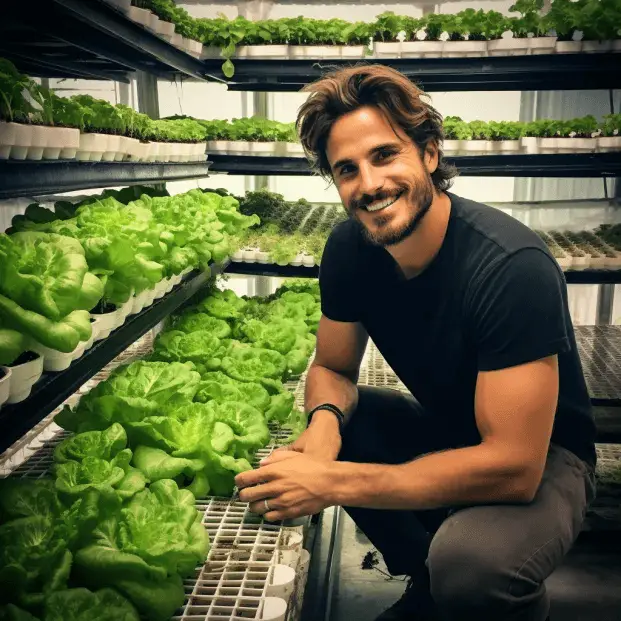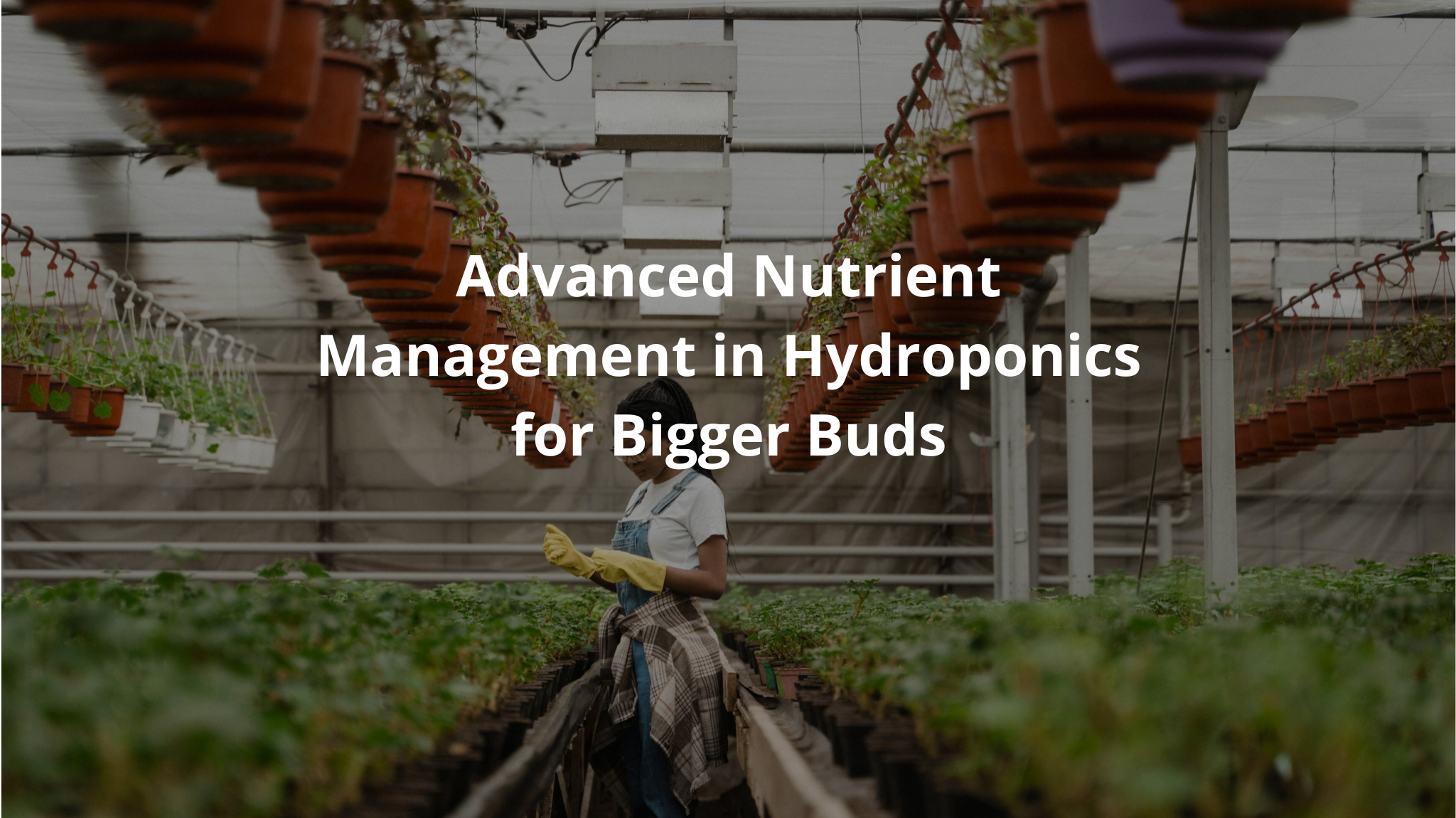Managing nutrients in hydroponics is important for growing healthy plants. If someone wants to see bigger buds and higher yields, understanding how to balance nutrients is key. They might wonder how to do this.
Keep reading to find out how pH levels, nutrient mixes, and even things like coco coir can make a big difference!
Key Takeaway
- Proper pH levels are crucial for nutrient uptake in plants.
- Using a high-quality nutrient mix can lead to bigger buds and faster growth.
- Regular monitoring of your grow room can help maintain optimal plant health.
Nutrient Composition is Key
Credits: JimmyB Harvest
When growing plants in hydroponics, focusing on some key nutrients is important. There are two main types: macronutrients and micronutrients.(1)
- Macronutrients: These are the big players. They include nitrogen (N), phosphorus (P), and potassium (K).
- Nitrogen helps leaves grow strong.
- Phosphorus is crucial for roots and flowers.
- Potassium helps plants use water properly.
- Micronutrients: These are smaller but still very important. They include iron, manganese, and zinc. Even though plants don’t need them in large amounts, these nutrients help keep plants healthy.
If the nutrients aren’t right, plants can struggle. For example, a friend’s plants looked droopy because they lacked nitrogen. This showed how vital these nutrients are for healthy growth.
Formulating the Perfect Nutrient Solution

Making a nutrient solution is like mixing a special drink for plants. It is important to find the right balance of nutrients. Speaking with an agronomist can help someone understand what their plants need.
Different plants require different nutrient mixes. For example, tomatoes need a different N-P-K ratio compared to lettuce. When trying to grow basil, one didn’t adjust their nutrient levels, and the plants didn’t thrive.
Also, changing the nutrient solution regularly is key. If someone doesn’t do this, harmful substances can build up, which can harm the plants. Think of it like changing the water in a fish tank. If it is not done, things can get messy!
Monitoring pH and EC Levels
Keeping track of pH levels is very important for healthy plants. The best pH range for hydroponics is between 5.5 and 6.5. If the pH is too high or too low, plants can’t absorb nutrients well.
One learned this lesson when they forgot to check their pH meter. Their plants started looking sick, and they were puzzled. Once they adjusted the pH, the plants perked right back up!
It is also important to watch electrical conductivity (EC) levels. EC tells how many nutrients are in the solution. If it’s too high or too low, plants can face problems.
Here are some tips for monitoring pH and EC levels:
- Use Reliable Meters: Invest in good pH and EC meters. They provide accurate readings, which helps in making the right adjustments.
- Regular Testing: Test the levels regularly. Daily checks can help catch issues before they affect plant health.
- Adjust as Needed: If the pH or EC is off, adjust it slowly. Sudden changes can shock the plants.
Tools like pH perfect technology can help keep everything balanced. By monitoring these levels closely, gardeners can support their plants in growing strong and healthy.
Best Practices for Nutrient Management
Here are some helpful tips for managing nutrients in hydroponics:
- Regular Monitoring: Check pH and nutrient levels often. This helps catch problems before they become serious.
- Quality Solutions: Use high-quality nutrient mixes. This makes a big difference in plant health. Products like bud candy and voodoo juice can give plants an extra boost.
- System Maintenance: Clean the hydroponic system regularly. This prevents issues like clogged pipes or harmful bacteria. One had to clean their system after using a bad batch of nutrients, and it was a real hassle!
By following these best practices, plants can grow strong and healthy. Keeping an eye on pH and EC levels is key to a successful hydroponic garden.(2)
Benefits of Advanced Nutrient Management
Managing nutrients well brings many great benefits.
- Increased Crop Yields: Proper nutrient solutions can boost crop yields by up to 30%. It is amazing to see friends’ faces light up when they harvest a ton of tomatoes from their plants!
- Water Efficiency: Hydroponics uses much less water than traditional farming—up to 95% less! This means one can grow more while using less water, which is good for the planet.
- Crop Diversity: With smart nutrient management, it is possible to grow a wider variety of crops. If someone wants to try something new, like growing cannabis with big bud or using sensi cal mag for extra calcium, they can do it!
Choosing the Right Growing Medium
The growing medium chosen can affect how well plants absorb nutrients. Coco coir is a popular option because it holds moisture well and lets roots breathe. One has used it, and their plants seem to thrive!
If someone is using a different medium, they should ensure it works well with the nutrients they are using. Some mediums may not hold nutrients as effectively, which can lead to plant deficiencies.
Choosing the right medium and managing nutrients helps plants grow strong and healthy. By paying attention to these details, gardeners can enjoy a bountiful harvest.
Nutrient Levels and Plant Health
Keeping track of nutrient levels is very important for plant health. High nutrient levels can be beneficial, but too much can be harmful. Everyone wants their plants to be healthy and happy!
Here are some things to remember:
- Balance is Key: A good balance of nutrients helps plants grow strong. Too much of a good thing can lead to problems.
- Watch for Signs: Keep an eye on the plants. If they look burnt at the tips, it might mean they are getting too many nutrients.
- Follow Feeding Charts: Always stick to feeding charts. They guide on how much to give plants. Adjust according to the plants’ needs.
One learned this lesson the hard way. They once overfed their plants with a nutrient mix that had too many trace elements. The plants ended up looking burnt at the tips. It was a sad sight.
If nutrient levels are too low, plants can also struggle. They may become weak and not produce well. Finding the right balance is essential for healthy growth.
It is important to check nutrient levels regularly. This helps catch problems early. Healthy plants lead to better yields and happier gardeners. By paying attention to nutrient levels, gardeners can create a thriving environment for their plants.
Conclusion
Advanced nutrient management in hydroponics can really help boost plant growth and yields. By keeping an eye on pH levels, using high-quality nutrient mixes, and maintaining the system, one can see healthier plants and bigger buds. It is all about paying attention to what plants need and reacting accordingly. The next time someone is in their grow room, they should remember these tips and watch their plants thrive!
FAQ
What is the ideal pH range for hydroponics, and how can I adjust pH levels effectively?
The best pH range for hydroponics is usually between 5.5 and 6.5. Keeping your pH levels in this range is important because it helps plants take up nutrients properly. You can use a pH meter to check the levels. If your pH is too high or too low, you can adjust it by pouring a bottle of pH adjusters into your nutrient solution. Checking the pH regularly will help your plants grow strong and healthy.
How do cal mag and other nutrients affect plant growth in hydroponics?
Cal mag is crucial for healthy plant roots and overall growth in hydroponics. It provides calcium and magnesium, which help plants absorb nutrients better. Using a good nutrient mix that includes cal mag can lead to bigger buds and higher yields. Adding amino acids can also help plants take in nutrients more effectively, leading to faster growth and healthier plants.
What role do bloom boosters like bud ignitor and bud candy play in maximizing yields?
Bloom boosters like bud ignitor and bud candy help plants during the flowering stage by making buds bigger and improving quality. These products provide extra nutrients that support plant growth when it matters most. By using these bloom boosters along with a feeding chart, you can get higher yields and enhance the tasty flavors of your harvest.
How does water quality impact nutrient levels in hydroponic systems?
Water quality is very important for nutrient levels in hydroponic systems. If the water has too many contaminants, it can hurt how well plants absorb nutrients. Using clean water helps ensure that your plants get the right balance of nutrients from your base nutrient solution. Testing water quality regularly will help keep everything in check, leading to healthier plants and better harvests.
What are the key components of an effective advanced nutrient management strategy in hydroponics?
A good advanced nutrient management strategy includes knowing about plant nutrition, monitoring pH and EC levels, and using high-quality growing media like coco coir or sensi coco. Products like voodoo juice can boost root mass and improve nutrient uptake. Following a simple guide with feeding charts for your grow room setup will help you achieve higher yields and keep your plants healthy throughout their life cycle.
References
- https://agrinextcon.com/nutrient-solutions-for-hydroponics-and-aeroponics/
- https://growdirector.com/nutrient-management-for-hydroponic-lettuce/
Related Articles
- https://tophydroponicgarden.com/how-do-you-know-when-to-add-nutrients/
- https://tophydroponicgarden.com/hydroponic-systems/
- https://tophydroponicgarden.com/commercial-hydroponic-kits/
Was this helpful?

I’m Barrie L., a passionate hydroponic gardening enthusiast dedicated to cultivating thriving, soil-less gardens. With a focus on all things hydroponic, I share my expertise on innovative growing techniques and sustainable practices through my blog, tophydroponicgarden.com. As a seasoned hydroponics specialist, my goal is to inspire and guide fellow gardeners in harnessing the power of water-based cultivation for bountiful and eco-friendly harvests. I’m also an author of the book “Hydroponics For Absolute Beginners: Your Step By Step Guide For How To Create An Hydroponics System At Home Without Soil, For Growing Vegetable, Fruit And Herbs.” which is sold on Amazon. Join me on a journey of redefining the way we cultivate plants, one nutrient-rich solution at a time. Happy growing!


